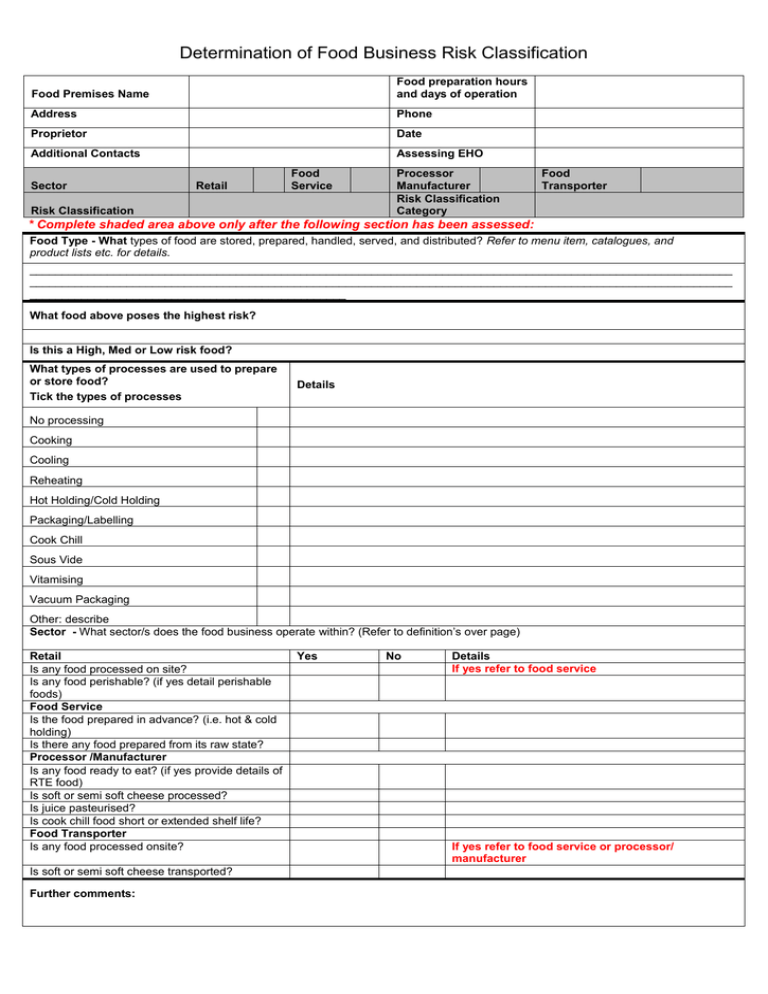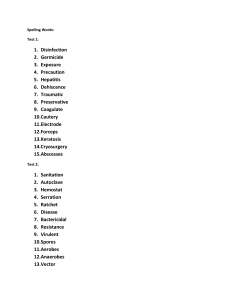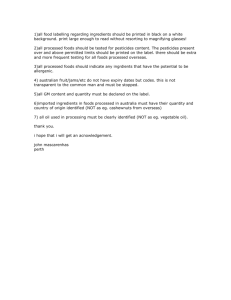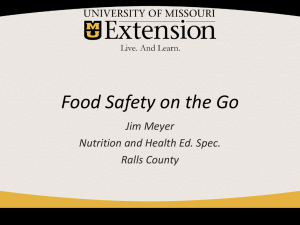Determination of risk form
advertisement

Determination of Food Business Risk Classification Food Premises Name Food preparation hours and days of operation Address Phone Proprietor Date Additional Contacts Assessing EHO Sector Retail Food Service Risk Classification Processor Manufacturer Risk Classification Category Food Transporter * Complete shaded area above only after the following section has been assessed: Food Type - What types of food are stored, prepared, handled, served, and distributed? Refer to menu item, catalogues, and product lists etc. for details. _____________________________________________________________________________________________________________ _____________________________________________________________________________________________________________ _________________________________________________ What food above poses the highest risk? Is this a High, Med or Low risk food? What types of processes are used to prepare or store food? Tick the types of processes Details No processing Cooking Cooling Reheating Hot Holding/Cold Holding Packaging/Labelling Cook Chill Sous Vide Vitamising Vacuum Packaging Other: describe Sector - What sector/s does the food business operate within? (Refer to definition’s over page) Retail Is any food processed on site? Is any food perishable? (if yes detail perishable foods) Food Service Is the food prepared in advance? (i.e. hot & cold holding) Is there any food prepared from its raw state? Processor /Manufacturer Is any food ready to eat? (if yes provide details of RTE food) Is soft or semi soft cheese processed? Is juice pasteurised? Is cook chill food short or extended shelf life? Food Transporter Is any food processed onsite? Is soft or semi soft cheese transported? Further comments: Yes No Details If yes refer to food service If yes refer to food service or processor/ manufacturer Determination of Food Business Risk Classification P1 P2 P3 P4 Sector Definition Retail Sells food to the public which is not processed on site (but can include packaging, labelling, hot holding, slicing & weighing). Generally includes supermarkets, convenience stores or specialty retail stores (e.g. bakery, butcher.) Food Service Makes and serves food for consumption on site, taken away for immediate consumption or at a catering event (may include transport). Processor / Manufacturer Physically or chemically transforms food, food ingredients, substances or components into new products. Can be sold via wholesaler or direct to business. Can include minimal or widespread distribution. Food Transporter Transports or distributes pre-retail (in particular importation, wholesaling, wholesale storage and multipurpose wholesalers who distribute not only to retailers but also to restaurant owners and consumers). Priority 1 Priority 2 This classification relates to business sectors that will, characteristically handle foods that support the growth of pathogenic micro-organisms and where such pathogens are present or could, from experience or literature reports, be expected to be present. Their handling of food will, characteristically, also involve at least one step at which control actions must be implemented to ensure the safety of the food. Priority 1 business sectors are further characterised by known risk-increasing factors, such as potential for inadequate/incorrect temperature control (e.g. reheating or ‘hot holding’ of food), a consumer base that includes predominantly immunocompromised populations, the scale of production/service and others factors identified in the National Risk Validation Project (FSA & ME, 2002). Priority 3 This classification relates to business sectors that will only handle “low risk” or “medium risk” foods. A medium risk food is one that may contain harmful natural toxins or chemicals introduced at steps earlier in the food supply chain, or that: – may contain pathogenic microorganisms but will not normally support the formation of toxins or growth of pathogenic microorganisms due to food characteristics; or – is unlikely to contain pathogenic microorganisms due to food type or processing but may support the formation of toxins or growth of pathogenic microorganisms. Priority 4 Business sectors that will normally handle only “low risk” foods, i.e. those that are unlikely to contain pathogenic organisms and will not support their growth, and will not introduce microbial, physical or chemical hazards to the foods they sell or handle.





